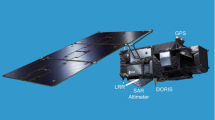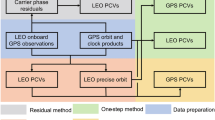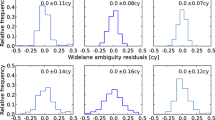Abstract
Most satellites in a low-Earth orbit (LEO) with demanding requirements on precise orbit determination (POD) are equipped with on-board receivers to collect the observations from Global Navigation Satellite systems (GNSS), such as the Global Positioning System (GPS). Limiting factors for LEO POD are nowadays mainly encountered with the modeling of the carrier phase observations, where a precise knowledge of the phase center location of the GNSS antennas is a prerequisite for high-precision orbit analyses. Since 5 November 2006 (GPS week 1400), absolute instead of relative values for the phase center location of GNSS receiver and transmitter antennas are adopted in the processing standards of the International GNSS Service (IGS). The absolute phase center modeling is based on robot calibrations for a number of terrestrial receiver antennas, whereas compatible antenna models were subsequently derived for the remaining terrestrial receiver antennas by conversion (from relative corrections), and for the GNSS transmitter antennas by estimation. However, consistent receiver antenna models for space missions such as GRACE and TerraSAR-X, which are equipped with non-geodetic receiver antennas, are only available since a short time from robot calibrations. We use GPS data of the aforementioned LEOs of the year 2007 together with the absolute antenna modeling to assess the presently achieved accuracy from state-of-the-art reduced-dynamic LEO POD strategies for absolute and relative navigation. Near-field multipath and cross-talk with active GPS occultation antennas turn out to be important and significant sources for systematic carrier phase measurement errors that are encountered in the actual spacecraft environments. We assess different methodologies for the in-flight determination of empirical phase pattern corrections for LEO receiver antennas and discuss their impact on POD. By means of independent K-band measurements, we show that zero-difference GRACE orbits can be significantly improved from about 10 to 6 mm K-band standard deviation when taking empirical phase corrections into account, and assess the impact of the corrections on precise baseline estimates and further applications such as gravity field recovery from kinematic LEO positions.
Similar content being viewed by others
References
Bertiger WI, Bar-Sever YE, Christensen EJ, Davis ES, Guinn JR, Haines BJ, Ibanez-Meier RW, Jee JR, Lichten SM, Melbourne WG, Muellerschoen RJ, Munson TN, Vigue Y, Wu SC, Yunck TP, Schutz BE, Abusali PAM, Rim HJ, Watkins MM, Willis P (1994) GPS precise tracking of TOPEX/POSEIDON: results and implications. J Geophys Res 99(C12): 24449–24464. doi:10.1029/94JC01171
Bettadpur S (2004) Gravity recovery and climate experiment product specification document. GRACE 327-720 (CSR-GR-03-02), Rev 4.2, Center for Space Research, The University of Texas at Austin
Beutler G (2005) Methods of celestial mechanics. Springer, Berlin
Bock H, Jäggi A, Švehla D, Beutler G, Hugentobler U, Visser P (2007) Precise orbit determination for the GOCE satellite using GPS. Adv Space Res 39(10): 1638–1647. doi:10.1016/j.asr.2007.02.053
Buckreuss S, Balzer W, Muhlbauer P, Werninghaus R, Pitz W (2003) The TerraSAR-X satellite project. In: Proceedings of IGARSS 2003, vol 5, Toulouse, pp 3096–3098
Dach R, Hugentobler U, Fridez P, Meindl M (eds) (2007) Bernese GPS Software Version 5.0. Documentation, Astronomical Institute, University of Bern, Bern
Dach R, Brockmann E, Schaer S, Beutler G, Meindl M, Prange L, Bock H, Jäggi A, Ostini L (2009) GNSS processing at CODE: status report. J Geod 83(3–4): 353–365. doi:10.1007/s00190-008-0281-2
Dow JM, Neilan RE, Gendt G (2005) The International GPS Service: celebrating the 10th anniversary and looking to the next decade. Adv Space Res 36(3): 320–326. doi:10.1016/j.asr.2005.05.125
Drinkwater M, Haagmans R, Muzi D, Popescu A, Floberghagen R, Kern M, Fehringer M (2006) The GOCE gravity mission: ESA’s first core explorer. In: Third GOCE User Workshop. 6–8 November 2006. Frascati, Italy, pp 1-7, ESA SP-627
Dunn C, Bertiger W, Bar-Sever Y, Desai S, Haines B, Kuang D, Franklin G, Harris I, Kruizinga G, Meehan T, Nandi S, Nguyen D, Rogstad T, Thomas JB, Tien J, Romans L, Watkins M, Wu SC, Bettadpur S, Kim J (2003) Instrument of GRACE. GPS World 14(2): 17– 28
Förste C, Flechtner F, Schmidt R, Meyer U, Stubenvoll R, Barthelmes F, König R, Neumayer KH, Rothacher M, Reigber C, Biancale R, Bruinsma S, Lemoine JM, Raimondo JC (2005) A new high resolution global gravity field model derived from combination of GRACE and CHAMP mission and altimetry/gravimetry surface gravity data. Geophys Res Abstr 7: 04561
Förste C, Schmidt R, Stubenvoll R, Flechtner F, Meyer U, König R, Neumayer H, Biancale R, Lemoine JM, Bruinsma S, Loyer S, Barthelmes F, Esselborn S (2008) The GeoForschungsZentrum Potsdam/Groupe de Recherche de Géodésie Spatiale satellite-only and combined gravity field models: EIGEN-GL04S1 and EIGEN-GL04C. J Geod 82(6): 331–346. doi:10.1007/s00190-007-0183-8
Flechtner F, Schmidt R, Meyer U, Schöne T, Esselborn S, Förste C, Stubenvoll R, Rudenko S, König R, Neumayer KH, Rothacher M (2006) The Benefit of EIGEN Gravity Field Models for Altimetry and vice versa. In: Proceedings of the Symposium on 15 Years of Progress in Radar Altimetry. 13–18 March 2006. Venice, Italy, ESA SP-614
Flechtner F, Bettadpur S, Watkins M, Kruizinga G (2007) GRACE Science Data System Monthly Reports. Available at http://podaac.jpl.nasa.gov/grace/newsletter.html
Fu L-L, Christensen EJ, Yamarone CA, Lefebvre M, Ménard Y, Dorrer M, Escudier P (1994) TOPEX/POSEIDON mission overview. J Geophys Res 99(C12): 24369–24381. doi:10.1029/94JC01761
Haines B, Bar-Sever Y, Bertiger W, Desai S, Willis P (2004) One-centimeter orbit determination for Jason-1: new GPS-based strategies. Mar Geod 27(1–2): 299–318. doi:10.1080/01490410490465300
Haines B, Bar-Sever Y, Bertiger W, Desai S, Sibois A, Webb F, Young L (2008) Space-based satellite antenna maps; impact of different satellite antenna maps on LEO & terrestrial results. 2–6 June 2008. IGS Workshop, Miami, USA
Jacchia LG (1971) Revised static models of the termosphere and exosphere with empirical temperature profiles. SAO Special Report 332
Jäggi A, Hugentobler U, Beutler G (2006) Pseudo-stochastic orbit modeling techniques for low-Earth orbiters. J Geod 80(1): 47–60. doi:10.1007/s00190-006-0029-9
Jäggi A, Hugentobler U, Bock H, Beutler G (2007) Precise orbit determination for GRACE using undifferenced or doubly differenced GPS data. Adv Space Res 39(10): 1612–1619. doi:10.1016/j.asr.2007.03.012
Jäggi A, Beutler G, Prange L, Dach R, Mervart L (2008) Assessment of GPS-only observables for gravity field recovery from GRACE. In: Sideris MG (eds) Observing our changing Earth. Springer, Berlin, pp 113–123. doi:10.1007/978-3-540-85426-5_14
Kang Z, Tapley B, Bettadpur S, Ries J, Nagel P, Pastor R (2006) Precise orbit determination for the GRACE mission using only GPS data. J Geod 80(6): 322–331. doi:10.1007/s00190-006-0073-5
Koop R, Gruber T, Rummel R (2006) The status of the GOCE high-level processing facility. In: Third GOCE User Workshop. 6–8 November 2006. Frascati, Italy, pp 195–205, ESA SP-627
Krieger G, Moreira A, Fiedler H, Hajnsek I, Werner M, Younis M, Zink M (2007) TanDEM-X: a satellite formation for high-resolution SAR interferometry. IEEE Trans Geosci Remote Sens 45(11): 3317–3341. doi:10.1109/TGRS.2007.900693
Kroes R, Montenbruck O, Bertiger W, Visser PNAM (2005) Precise GRACE baseline determination using GPS. GPS Solut 9(1): 21–31. doi:10.1007/s10291-004-0123-5
Kroes R (2006) Precise relative positioning of formation flying spacecraft using GPS, vol 61. Publications on Geodesy, Netherlands Geodetic Commission
Lemoine FG, Smith DE, Kunz L, Smith R, Pavlis EC, Pavlis NK, Klosko SM, Chinn DS, Torrence MH, Williamson RG, Cox CM, Rachlin KE, Wang YM, Kenyon SC, Salman R, Trimmer R, Rapp RH, Nerem RS (1997) The development of the NASA GSFC and NIMA joint geopotential model. In: Segawa J, Fujimoto H, Okubo S (eds) IAG symposia: gravity, geoid and marine geodesy. Springer, Berlin, pp 461–469
Luthcke SB, Zelensky NP, Rowlands DD, Lemoine FG, Williams TA (2003) The 1-centimeter orbit: Jason-1 precision orbit determination using GPS, SLR, DORIS, and altimeter data. Mar Geod 26(3): 399–421. doi:10.1080/01490410390256727
Montenbruck O, Kroes R (2003) In-flight performance analysis of the CHAMP BlackJack GPS receiver. GPS Solut 7(2): 74–86. doi:10.1007/s10291-003-0055-5
Montenbruck O, van Helleputte T, Kroes R, Gill E (2005) Reduced-dynamic orbit determination using GPS code and carrier measurements. Aerosp Sci Technol 9(3): 261–271. doi:10.1016/j.ast.2005.01.003
Montenbruck O, Garcia-Fernandez M, Williams J (2006) Performance comparison of semi-codeless GPS receivers for LEO satellites. GPS Solut 10(4): 249–261. doi:10.1007/s10291-006-0025-9
Montenbruck O, Andres Y, Bock H, van Helleputte T, van den Ijssel J, Loiselet M, Marquardt C, Silvestrin P, Visser P, Yoon Y (2008) Tracking and orbit determination performance of the GRAS instrument on MetOp-A. GPS Solut 12(4): 289–299. doi:10.1007/s10291-008-0091-2
Montenbruck O, Garcia-Fernandez M, Yoon Y, Schön S, Jäggi A (2009) Antenna phase center calibration for precise positioning of LEO satellites. GPS Solut 13(1): 23–34. doi:10.1007/s10291-008-0094-z
Pail R, Metzler B, Lackner B, Preimesberger T, Höck E, Schuh W-D, Alkathib H, Boxhammer C, Siemes C, Wermuth M (2006) GOCE gravity field analysis in the framework of HPF: operational software system and simulation results. In: 3rd GOCE User Workshop. 6–8 November 2006. Frascati, Italy, ESA SP-627, pp 249–256
Pearlman MR, Degnan JJ, Bosworth JM (2002) The International laser ranging service. Adv Space Res 30(2): 135–143. doi:10.1016/S0273-1177(02)00277-6
Reigber C, Lühr H, Schwintzer P (1998) Status of the CHAMP mission. In: Rummel R, Drewes H, Bosch W, Hornik H (eds) Towards an integrated global geodetic observing system (IGGOS). Springer, Berlin, pp 63–65
Reigber C, Schwintzer P, Neumayer KH, Barthelmes F, König R, Förste C, Balmino G, Biancale R, Lemoine JM, Loyer S, Bruinsma S, Perosanz F, Fayard T (2003) The CHAMP-only earth gravity field model EIGEN-2. Adv Space Res 31(8): 1883–1888. doi:10.1016/S0273-1177(03)00162-5
Rockwell International Corporation (1984) GPS interface control document, ICD-GPS-200. Satellite Systems Division
Rothacher M, Schaer S, Mervart L, Beutler G (1995) Determination of antenna phase center variations using GPS data. In: Gendt G, Dick G (eds) Proc 1995 IGS Workshop. GeoForschungsZentrum Potsdam, Potsdam, pp 205–220
Schmid R, Rothacher M, Thaller D, Steigenberger P (2005) Absolute phase center corrections of satellite and receiver antennas—impact on global GPS solutions and estimation of azimuthal phase center variations of the satellite antenna. GPS Solut 9(4): 283–293. doi:10.1007/s10291-005-0134-x
Schmid R, Steigenberger P, Gendt G, Ge M, Rothacher M (2007) Generation of a consistent absolute phase center correction model for GPS receiver and satellite antennas. J Geod 81(12): 781–798. doi:10.1007/s00190-007-0148-y
Švehla D, Rothacher M (2005) Kinematic precise orbit determination for gravity field determination. In: Sansò F (eds) A window on the future of geodesy. Springer, Berlin, pp 181–188. doi:10.1007/3-540-27432-4_32
TanDEM-X mission requirements document (2007) TDX-PD-RS- 0001. DeutschesZentrum fürLuft und Raumfahrt, Oberpfaffenhofen
Tapley BD, Bettadpur S, Watkins M, Reigber C (2004) The gravity recovery and climate experiment: mission overview and early results. Geophys Res Lett 31(9): L09607. doi:10.1029/2004GL019920
Teunissen PJG, Kleusberg A (1998) GPS observation equations and positioning concepts. In: Teunissen PJG, Kleusberg A (eds) GPS for Geodesy. Springer, Berlin, pp 187–229
van Helleputte T (2004) User manual for the GHOST orbit determination software, FDS-SUM-3110. Deutsches Zentrum für Luft und Raumfahrt, Oberpfaffenhofen
van Helleputte T, Visser P (2008) GPS based orbit determination using accelerometer data. Aerosp Sci Technol 12(6): 478–484. doi:10.1016/j.ast.2007.11.002
Vallado DA, Finkelman D (2008) A critical assessment of satellite drag and atmospheric density modeling. In: Astrodynamics specialist conference and exhibit. 18–21 August 2008. Honolulu, Hawaii, AIAA 2008-6442
Wu SC, Yunck TP, Thornton CL (1991) Reduced-dynamic technique for precise orbit determination of low Earth satellites. J Guid Control Dyn 14(1): 24–30
Wu BH, Chu V, Chen P, Ting T (2005) FORMOSAT-3/COSMIC science mission update. GPS Solut 9(2): 111–121. doi:10.1007/s10291-005-0140-z
Yoon Y, Eineder M, Yague-Martinez N, Montenbruck O (2009) TerraSAR-X precise trajectory estimation and quality assessment. IEEE Trans Geosci Remote Sens. doi:10.1109/TGRS.2008.2006983
Author information
Authors and Affiliations
Corresponding author
Rights and permissions
About this article
Cite this article
Jäggi, A., Dach, R., Montenbruck, O. et al. Phase center modeling for LEO GPS receiver antennas and its impact on precise orbit determination. J Geod 83, 1145–1162 (2009). https://doi.org/10.1007/s00190-009-0333-2
Received:
Accepted:
Published:
Issue Date:
DOI: https://doi.org/10.1007/s00190-009-0333-2




